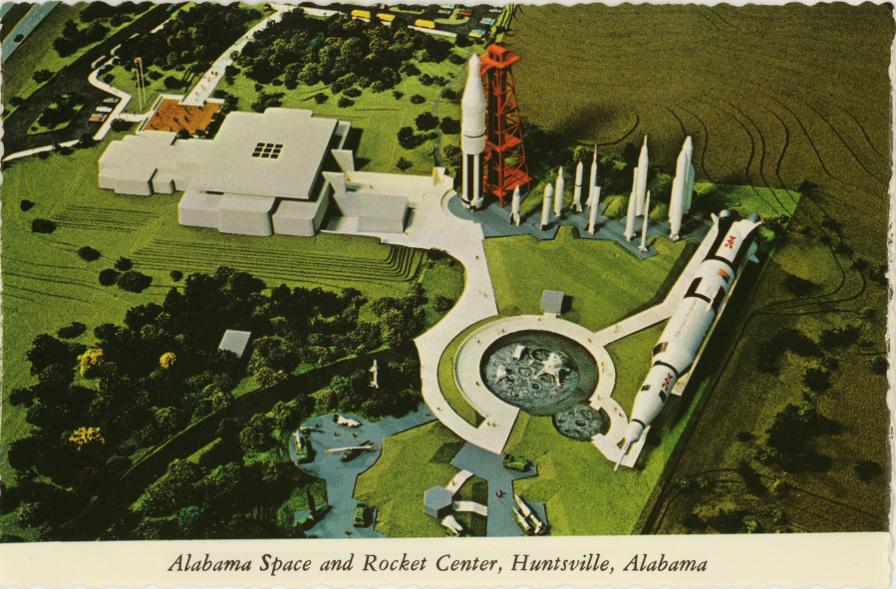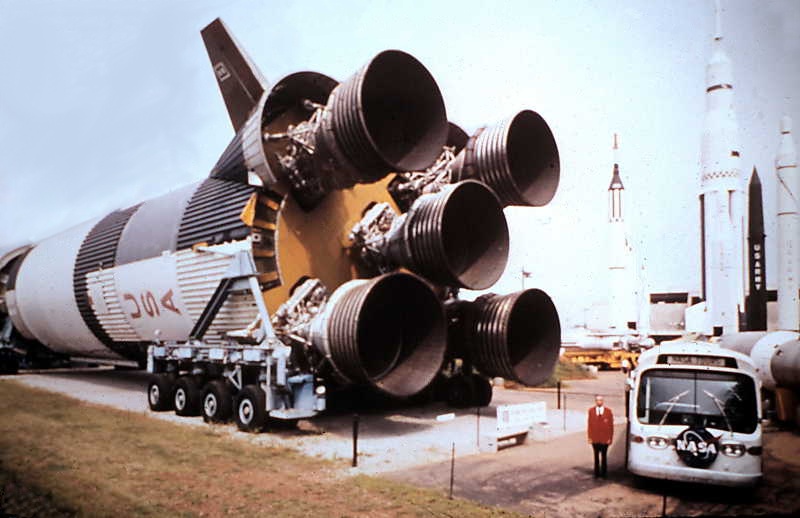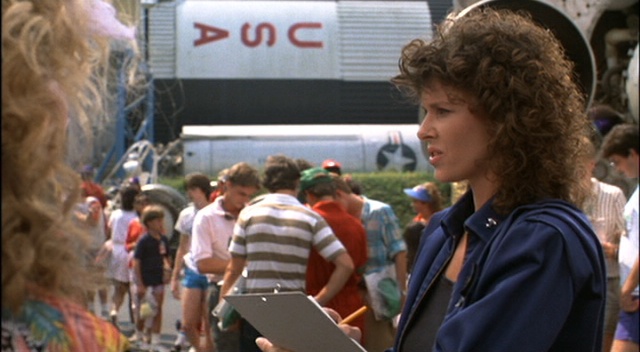Vintage U.S. Space & Rocket Center Photos
This page is a repository for vintage photos of U.S. Space & Rocket Center (or Alabama Space and Rocket Center, as the case may be).
This postcard was likely on sale when the Alabama Space & Rocket Center opened in March of 1970 – it appears to have been printed before aerial photos of the Rocket Park were available: Rather than a photo or drawing of the actual Rocket Park, it consists of what appears to be photo of a model of the ASRC.
This model shows a much more ambitious display than was actually built. It shows a cluster of rockets and missiles including the V-2, Jupiter, Juno II, Army Redstone, Jupiter-C, and Mercury-Redstone. Other than the V-2 (which has subsequently been restored and is displayed indoors), this cluster of rockets is still present in the same configuration in the Rocket Park.
The model additionally shows a Saturn IB with umbilical tower (rather than the towerless Block II Saturn I which is actually present). Oddly enough, the Saturn IB is depicted without fins and the Apollo Command Module is shown without a launch escape tower.
There's a second cluster of rockets and missiles, located south of the existing cluster. This cluster appears to contain a Thor-Able (or an early Delta), a vertically-displayed Mercury-Atlas (although the Rocket Park does host a horizontally-displayed Atlas F), what appears to be some sort sounding rocket, a vertically-displayed Titan II (although the Rocket Park formerly had a horizontally-displayed Titan II) and some sort of rocket with large, strap-on solid rocket boosters (perhaps a Titan IIIC?).
And the Saturn V was displayed in the Rocket Park as a single, integrated vehicle (including its interstages). The Saturn V was actually displayed without its interstages (allowing inspection of the second and third stage engines, which makes for a far more interesting display).
This same photo appeared in the centerfold of the first ASRC brochure.
Click image for a 3597x2365 pixel version of this image in a new window.
Scan by heroicrelics.
Here's a photo of the Saturn V in the Rocket Park with a bus; presumably, this is a bus which would take visitors to tour Marshall Space Flight Center.
It's hard to date this photo, but I see that the grounds have been paved and there's a Titan missile (based on the fact that the second stage is a smaller diameter than the first stage, I'd guess that it's a Titan I). The grounds were not paved at the time of my early Alabama Space & Rocket Center souvenir booklet. I don't know whether the grounds were paved at the time of my Official Guide to the Alabama Space & Rocket Center (circa 1972), but there was a Titan in the Rocket Park in this approximate location.
From somewhere on the Internet (likely an eBay auction).
Clean-up by heroicrelics.
This photo shows the interior of the main exhibit area ("Space Hall", according to one of my brochures). This dates back to when Apollo 6 was exhibited at the ASRC. This photo seems to date back to the approximate time of my early Alabama Space & Rocket Center souvenir booklet, and shows the same artifacts (Apollo 6, an Instrument Unit, an X-15 mockup, and a Gemini-era Agena upper stage) but from the opposite side of the gallery as page 13 from that brochure.
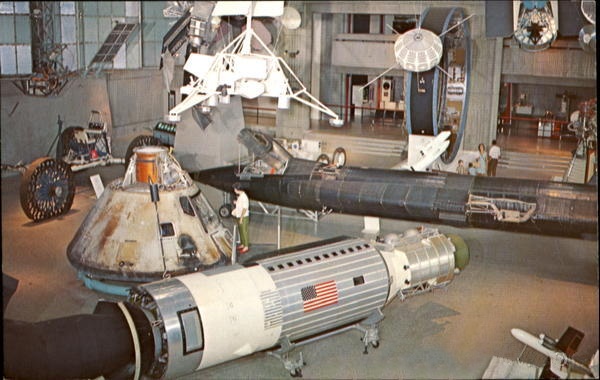
From somewhere on the Internet (likely an eBay auction).
Clean-up by heroicrelics.
Many scenes from the movie Space Camp where shot on the USSRC grounds. The movie, about a problem with a Space Shuttle SRB which caused an accidental launch (hey, I don't make this stuff up), was originally intended to be released in early 1986, but the Challenger disaster on January 26, 1986 delayed its release. Based on its release date, I assume that the movie must have been shot at the USSRC in the spring or summer of 1985, providing a reference for various artifacts.
In this scene, we see that the V-2 is still located in the Rocket Park (between the two left-most actors). Also, the Saturn V interstages (the grey cylinder to the left of the Saturn I) are still located in the Rocket Park.
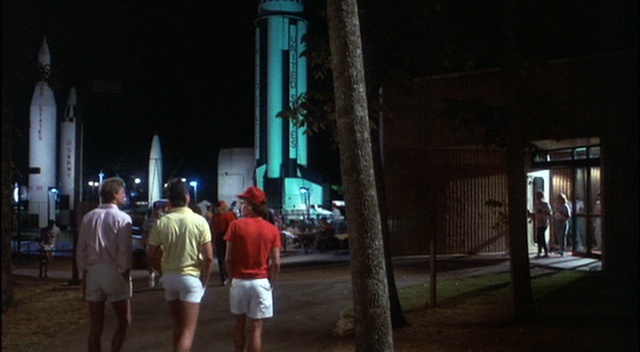
Video capture from Space
Camp.
Capture and clean-up by heroicrelics.
In the background, just in front of the Saturn V S-IC stage, we see a Titan missile. Based on the longitudinal structural rib on the aft portion of the missile, I'd guess that it's a Titan II (and the USSRC did have a Titan II on display in the early 2000s).
Video capture from Space
Camp.
Capture and clean-up by heroicrelics.
Looking at the Atlas' engine above Kate Capshaw's right shoulder, it appears that the Atlas boattail (or at least engine fairing) is not installed, allowing inspection of the engine's plumbing and turbopump. Below is a full-size crop of a page from an early ASRC souvenir booklet (probably dating back to the museum's opening in 1970) also showing the lack of an engine covering.

Video capture from Space
Camp.
Capture and clean-up by heroicrelics.
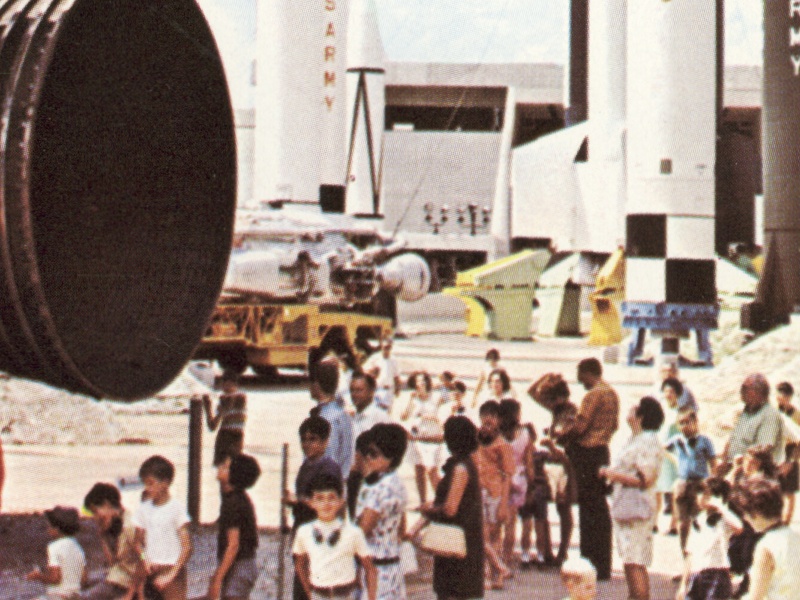
Full-size crop from page 31 of my early Alabama Space & Rocket Center souvenir booklet.
Here we see that the support arms on the Saturn I are either white or a perhaps a light grey. Alternating support arms were originally painted yellow and green (matching most or all of the vintage Saturn I launch photos I've seen), as seen above in the background of the Atlas photo above. Since I've been visiting, the support arms have been painted blue.
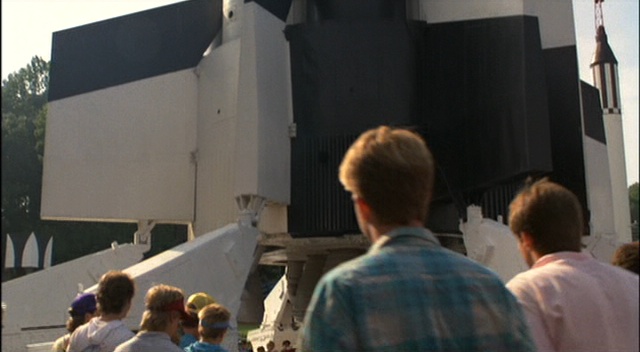
Video capture from Space
Camp.
Capture and clean-up by heroicrelics.
The photo below is from John Glenn's presidential campaign kick-off held at the USSRC in 1983. If you look closely, it appears that the support arms are still yellow and green, so it would appear that they were repainted sometime in the roughly two years between the campaign event and filming.
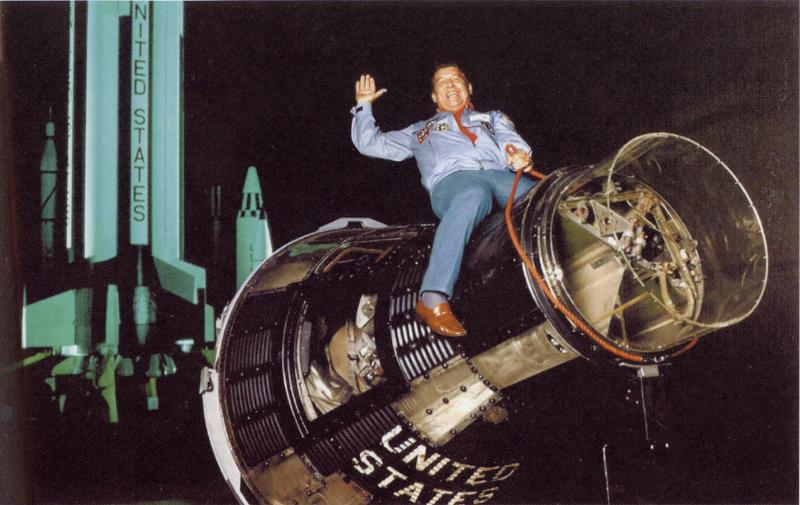
From the color section of The Real
Space Cowboys.
Scan by heroicrelics.
This scene takes place in the main exhibit area of the "old" museum (apparently known as "Space Hall" at one time). The Lunar Roving Vehicle (LRV) was displayed in front of the Lunar Module, with the LM trainer in the background. (The white sphere at center is an annoying robot from the movie.)
There are two things of interest in this shot: It is possible to see the Saturn V out the windows of the museum. Originally, the museum was brightly-lit from its glass walls and doors. When the Skylab solar array was put on display, the museum had to paint over the glass to prevent the solar array from generating electricity and posing a shock hazard.
The other thing of interest is the "13" in the red circle above the door. In the circa-1972 Official Guide to the Alabama Space & Rocket Center brochure, various areas were assigned numbers on the brochure's museum map. Number 13 was the exit from Space Hall to the Rocket Park, so it's interesting that this nomenclature survived from around 1972 through 1985.

Video capture from Space
Camp.
Capture and clean-up by heroicrelics.
This frame, just left of the LRV frame above, shows Sigma 7, the third U.S. manned orbital Mercury spacecraft it is currently exhibited at the Astronaut Hall of Fame. Sigma 7 was in the early ASRC souvenir booklet I have, so it appears that the spacecraft spent at least 15 years in Huntsville.

Video capture from Space
Camp.
Capture and clean-up by heroicrelics.
And here we see that annoying robot wheeling past the museum's cut-away RL-10 rocket engine.
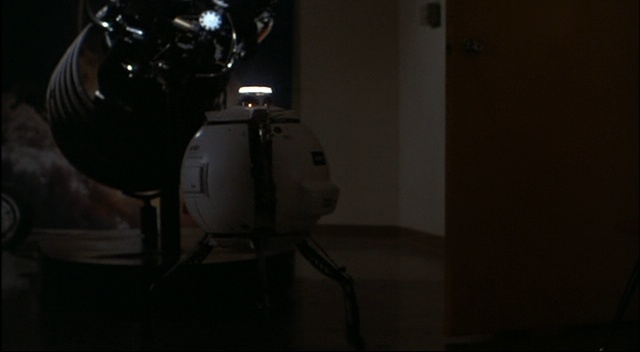
Video capture from Space
Camp.
Capture and clean-up by heroicrelics.
For more information and documents from the USSRC's history, see my First Alabama Space & Rocket Center Brochure, my early Alabama Space & Rocket Center souvenir booklet, my Official Guide to the Alabama Space & Rocket Center brochure, and my Political Career of Sigma 7 page. Also see Hab1.com, which has a couple of additional ASRC brochures: one, two.

